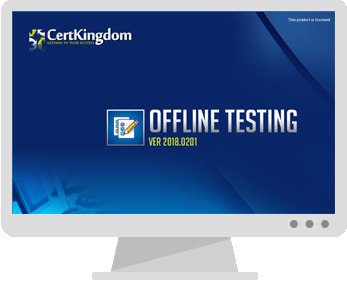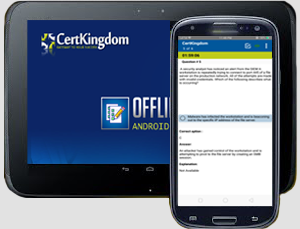Exam: 70-513

|
|||||||||||||||||||||||||||
Certkingdom's preparation material includes the most excellent features, prepared by the same dedicated experts who have come together to offer an integrated solution. We provide the most excellent and simple method to pass your certification exams on the first attempt "GUARANTEED"
Whether you want to improve your skills, expertise or career growth, with Certkingdom's training and certification resources help you achieve your goals. Our exams files feature hands-on tasks and real-world scenarios; in just a matter of days, you'll be more productive and embracing new technology standards. Our online resources and events enable you to focus on learning just what you want on your timeframe. You get access to every exams files and there continuously update our study materials; these exam updates are supplied free of charge to our valued customers. Get the best 70-513 exam Training; as you study from our exam-files "Best Materials Great Results"
70-513 Exam + Online / Offline and Android Testing Engine & 4500+ other exams included
$50 - $25 (you save $25)
Buy Now
70-513
TS: Windows Communication Foundation Development with Microsoft .NET Framework 4
About this Exam
This exam is designed to test the candidate's knowledge and skills for developing applications using Windows Communication Foundation and the .NET Framework 4.
Questions that contain code will be presented in either VB or C#. Candidates can select one of these languages when they start the exam.
Audience Profile
The candidate works on a team in a development environment that uses Microsoft Visual Studio 2010 and .NET Framework 4 to build distributed applications. This candidate should have at least one year of experience developing Windows Communication Foundation (WCF)–based applications, including at least six months of experience with .NET Framework 4. The candidate should also be able to demonstrate the following:
A solid understanding of WCF in the context of the .NET Framework 4 solution stack
Experience creating service model elements
Experience using WCF to support open and .NET communication
Experience configuring and deploying WCF applications
Experience using Visual Studio tools, tracing tools, SvcUtil, WCF performance monitoring, and IIS/WAS for hosting services
Experience securing WCF applications
A solid understanding of concurrency
Credit Toward Certification
When you pass Exam 70-513: TS: Windows Communication Foundation Development with Microsoft .NET Framework 4, you complete the requirements for the following certification(s):
MCTS: .NET Framework 4, Service Communication Applications
Exam 70-513: TS: Windows Communication Foundation Development with Microsoft .NET Framework 4: counts as credit toward the following certification(s):
MCPD: Windows Developer 4
MCPD: Web Developer 4
Note This preparation guide is subject to change at any time without prior notice and at the sole discretion of Microsoft. Microsoft exams might include adaptive testing technology and simulation items. Microsoft does not identify the format in which exams are presented. Please use this preparation guide to prepare for the exam, regardless of its format.
Skills Being Measured
This exam measures your ability to accomplish the technical tasks listed below. The percentages indicate the relative weight of each major topic area on the exam.
Creating Services (20%)
Create service and operation contracts.
This objective may include but is not limited to: one-way, duplex, and request reply; creating and specifying fault contracts; configuration-based contracts; exposing service metadata; selecting serialization (e.g., data contract serializer vs. XML serializer)
This objective does not include: designing service and operation contracts; transactions, instantiation, security-related attributes
Create data contracts.
This objective may include but is not limited to: managing Known Types; controlling data serialization; using required and order attributes on data members; implementing versioning using IExtensibleDataObject; POCOs
This objective does not include: using custom serializer (ISerializationSurrogate)
Create message contracts.
This objective may include but is not limited to: body and header elements; using required and order attributes on members
Implement generic message handling.
This objective may include but is not limited to: creating a catch-all contract; reading and writing messages; working with properties; working with headers
This objective does not include: inheriting from Message class; using BodyWriter; creating Fault messages
Implement RESTful services.
This objective may include but is not limited to: accessing HTTP context; WebGet/WebInvoke, UriTemplates; JSON/POX
Create and configure a Routing service.
This objective may include but is not limited to: filters, static and dynamic, context-based routing, content-based routing; router interfaces
Create and configure a Discovery service.
This objective may include but is not limited to: configuring ad hoc and managed modes; Discovery scopes; service announcements
Hosting and Configuring Services (18%)
Create and configure endpoints.
This objective may include but is not limited to: default and standard bindings; custom bindings created from standard binding elements; standard endpoints; transports including HTTP, TCP, named pipes, UDP, MSMQ code-based service configuration; message encoding
This objective does not include: creating a custom binding element; creating new standard endpoints, loading configuration from a location other than the default application configuration file, security, transaction, reliable sessions
Configure Behaviors.
This objective may include but is not limited to: applying service, endpoint, and operation behaviors in configuration and code
This objective does not include: creating a custom behavior; creating and using dispatch behaviors, loading configuration from a location other than the default application configuration file
Implement self hosting.
This objective may include but is not limited to: configuring and instantiating a service host
This objective does not include: implementing a custom service host
Implement Web server hosting.
This objective may include but is not limited to: configuring IIS/WAS for WCF; deploying to IIS/WAS; file-less configuration; specifying a ServiceHost
This objective does not include: Windows Application Server
Consuming Services (18%)
Create a service proxy.
This objective may include but is not limited to: using a proxy class or channel factory to create a proxy; creating a proxy for an asynchronous communication; creating a proxy for a duplex communication
This objective does not include: SvcUtil command-line switches
Configure client endpoints.
This objective may include but is not limited to: standard bindings, custom bindings created from standard binding elements, configuring behaviors; code-based and configuration-based bindings; configuring addresses
This objective does not include: security; creating custom behaviors
Invoke a service.
This objective may include but is not limited to: invoking a service operation synchronously and asynchronously; handling service faults ; using the Message class; managing the life cycle of the proxy (open channels, close channels, abort channels, handle faulted channels); implementing duplex communication
Consume RESTful services.
This objective may include but is not limited to: access HTTP context; JSON/POX
Implement service Discovery.
This objective may include but is not limited to: configuring target scope; monitoring service announcements
Securing Services (17%)
Configure secure Bindings.
This objective may include but is not limited to: transport, message, mixed mode
Configure message security.
This objective may include but is not limited to: specifying protection levels on different message parts
Implement Authentication.
This objective may include but is not limited to: Microsoft ASP.NET Membership Provider, Custom Provider, Windows Integrated Security, certificates (X.509), Federated Authentication endpoint identity; configuring client credentials; Custom Validator
This objective does not include: Geneva Framework
Implement Authorization.
This objective may include but is not limited to: role based, claim based; configuring role providers for endpoints; principal permission attribute
This objective does not include: rights-management authorization such as Active Directory Rights Management Services (AD RMS)
Implement Impersonation.
This objective may include but is not limited to: configuration and code; configuring WCF-specific Internet Information Services (IIS) impersonation properties; configuring impersonation options; operation-based and service-based
Implement security auditing.
This objective may include but is not limited to: using serviceSecurityAudit behavior, service auditing, audit log
Managing the Service Instance Life Cycle (13%)
Manage service instances.
This objective may include but is not limited to: per call; per session; single; code and configuration; activation and deactivation; durable services; throttling
Manage sessions.
This objective may include but is not limited to: code and configuration; session management attributes; throttling; reliable sessions; transport-level and application-level sessions; invoking a callback contract
Implement transactions.
This objective may include but is not limited to: distributed transactions; transactional queues;transaction flow; configuring transaction binding attributes; WS-AtomicTransaction (WS-AT); transactional behavior attributes at the service and operation level; using transactions in code
Manage concurrency.
This objective may include but is not limited to: single, multiple, and reentrant concurrency modes; SynchronizationContext and CallbackBehavior
This objective does not include: deadlocks and other multithreading issues
Manage consistency between instances, sessions, transactions, and concurrency.
This objective may include but is not limited to: possible combinations between instances, sessions, transactions, and concurrency (for example, instance mode single with concurrency mode multiple)
Monitoring and Troubleshooting Distributed Systems (14%)
Configure message logging.
This objective may include but is not limited to: configuring message listeners; logging level; message filters; configuring logging known PII
This objective does not include: secure message logs
Configure diagnostics.
This objective may include but is not limited to: WMI; performance counters; event logging
Debug client-service interactions.
This objective may include but is not limited to: sending server exception details to client; end-to-end tracing; interpreting output from the trace viewer (single message and end to end)
This objective does not include: tracing viewer features outside of viewing traces
Make yourself more valuable in today's competitive computer industry Certkingdom's preparation material includes the most excellent features, prepared by the same dedicated experts who have come together to offer an integrated solution. We provide the most excellent and simple method to pass your Microsoft MCTS 70-513 exam on the first attempt "GUARANTEED".
Unlimited Access Package
will prepare you for your exam with guaranteed results, 70-513 Study Guide. Your exam will download as a single 70-513 PDF or complete 70-513 testing engine as well as over +4000 other technical exam PDF and exam engine downloads. Forget buying your prep materials separately at three time the price of our unlimited access plan - skip the 70-513 audio exams and select the one package that gives it all to you at your discretion: 70-513 Study Materials featuring the exam engine.
Certkingdom 70-513 Exam Prepration Tools
Certkingdom Microsoft MCTS preparation begins and ends with your accomplishing this credential goal. Although you will take each Microsoft MCTS online test one at a time - each one builds upon the previous. Remember that each Microsoft MCTS exam paper is built from a common certification foundation.
70-513 Exam Testing Engines
Beyond knowing the answer, and actually understanding the 70-513 test questions puts you one step ahead of the test. Completely understanding a concept and reasoning behind how something works, makes your task second nature. Your 70-513 quiz will melt in your hands if you know the logic behind the concepts. Any legitimate Microsoft MCTS prep materials should enforce this style of learning - but you will be hard pressed to find more than a Microsoft MCTS practice test anywhere other than Certkingdom.
70-513 Exam Questions and Answers with Explanation
This is where your Microsoft MCTS 70-513 exam prep really takes off, in the testing your knowledge and ability to quickly come up with answers in the 70-513 online tests. Using MCTS 70-513 practice exams is an excellent way to increase response time and queue certain answers to common issues.
70-513 Exam Study Guides
All Microsoft MCTS online tests begin somewhere, and that is what the Microsoft MCTS training course will do for you: create a foundation to build on. Study guides are essentially a detailed Microsoft MCTS 70-513 tutorial and are great introductions to new Microsoft MCTS training courses as you advance. The content is always relevant, and compound again to make you pass your 70-513 exams on the first attempt. You will frequently find these 70-513 PDF files downloadable and can then archive or print them for extra reading or studying on-the-go.
70-513 Exam Video Training
For some, this is the best way to get the latest Microsoft MCTS 70-513 training. However you decide to learn 70-513 exam topics is up to you and your learning style. The Certkingdom Microsoft MCTS products and tools are designed to work well with every learning style. Give us a try and sample our work. You'll be glad you did.
70-513 Other Features
* Realistic practice questions just like the ones found on certification exams.
* Each guide is composed from industry leading professionals real Microsoft MCTSnotes, certifying 100% brain dump free.
* Study guides and exam papers are guaranteed to help you pass on your first attempt or your money back.
* Designed to help you complete your certificate using only
* Delivered in PDF format for easy reading and printing Certkingdom unique CBT 70-513 will have you dancing the Microsoft MCTS jig before you know it
* MCTS 70-513 prep files are frequently updated to maintain accuracy. Your courses will always be up to date.
Get MCTS ebooks from Certkingdom which contain real 70-513 exam questions and answers. You WILL pass your MCTS exam on the first attempt using only Certkingdom's MCTS excellent preparation tools and tutorials.
These are real testimonials. Hi friends! CertKingdom.com is No1 in sites coz in $50 I cant believe this but when I purchased the $50 package it was amazing I Microsoft passed 10 Exams using CertKingdom guides in one Month So many thanks to CertKingdom Team , Please continue this offer for next year also. So many Thanks
Mike CA
Thank You! I would just like to thank CertKingdom.com for the Microsoft MCTS 70-513 test guide that I bought a couple months ago and I took my test and pass overwhelmingly. I completed the test of 473 questions in about 90 minutes I must say that their Q & A with Explanation are very amazing and easy to learn.
Jay Brunets
After my co-workers found out what I used to pass Microsoft MCTS 70-513 the test, that many are thinking about purchasing CertKingdom.com for their MCTS exams, I know I will again
John NA
I passed the Microsoft MCTS 70-513 exam yesterday, and now it's on to security exam. Couldn't have done it with out you. Thanks very much.
Oley R.
Hello Everyone
I Just Passed The Microsoft MCTS 70-513 Took 80 to 90 Minutes max to understand and easy to learn. Thanks For Everything Now On To 70-513
Robert R.
Hi CertKingdom.com thanks so much for your assistance in Microsoft MCTS i passed today it was a breeze and i couldn't have done it without you. Thanks again
Seymour G.
I have used your Exam Study Guides for preparation for Microsoft MCTS 70-513. I also passed all those on the first round. I'm currently preparing for the Microsoft and theMCTS. exams
Ken T.
I just wanted to thank you for helping me get myMCTS $50 package for all guides is awesome you made the journey a lot easier. I passed every test the first time using your Guide
Mario B.
I take this opportunity to express my appreciation to the authors of CertKingdom.com Microsoft MCTS test guide. I purchased the 70-513 soon after my formal hands on training and honestly, my success in the test came out of nowhere but CertKingdom.com. Once again I say thanks
Kris H.
Dear CertKingdom.com team the test no. 70-513 that i took was very good, I received 880 and could have gain more just by learning your exams
Gil L.
Hi and Thanks I have just passed the MCTS Directory Services Design exam with a score of 928 thanks to you! The guide was excellent
Edward T.
Great stuff so far....I love this site....!! I am also on the Microsoft MCTS I decided to start from certkingdom and start learning study MCTS from home... It has been really difficult but so far I have managed to get through 4 exams....., now currently studying for the more exams.... Have a good day.................................................. Cheers
Ted Hannam
Thanks for your Help, But I have finally downloaded Microsoft MCTS 70-513 exam preparation from certkingdom.com they are provided me complete information about the exam, lets hope I get success for the 70-513 exam, I found there exams very very realistic and useful. thanks again
lindsay Paul
Certkingdom Offline Testing Engine Simulator Download
Prepare with yourself how CertKingdom Offline Exam Simulator it is designed specifically for any exam preparation. It allows you to create, edit, and take practice tests in an environment very similar to an actual exam.
Supported Platforms: Windows-7 64bit or later - EULA | How to Install?
FAQ's: Windows-8 / Windows 10 if you face any issue kinldy uninstall and reinstall the Simulator again.
Download Offline Simulator-Beta
Certkingdom Testing Engine Features
- Certkingdom Testing Engine simulates the real exam environment.
- Interactive Testing Engine Included
- Live Web App Testing Engine
- Offline Downloadable Desktop App Testing Engine
- Testing Engine App for Android
- Testing Engine App for iPhone
- Testing Engine App for iPad
- Working with the Certkingdom Testing Engine is just like taking the real tests, except we also give you the correct answers.
- More importantly, we also give you detailed explanations to ensure you fully understand how and why the answers are correct.
Certkingdom Android Testing Engine Simulator Download
Take your learning mobile android device with all the features as desktop offline testing engine. All android devices are supported.
Supported Platforms: All Android OS EULA
Install the Android Testing Engine from google play store and download the app.ck from certkingdom website android testing engine download

Certkingdom Android Testing Engine Features
- CertKingdom Offline Android Testing Engine
- Make sure to enable Root check in Playstore
- Live Realistic practice tests
- Live Virtual test environment
- Live Practice test environment
- Mark unanswered Q&A
- Free Updates
- Save your tests results
- Re-examine the unanswered Q & A
- Make your own test scenario (settings)
- Just like the real tests: multiple choice questions
- Updated regularly, always current




